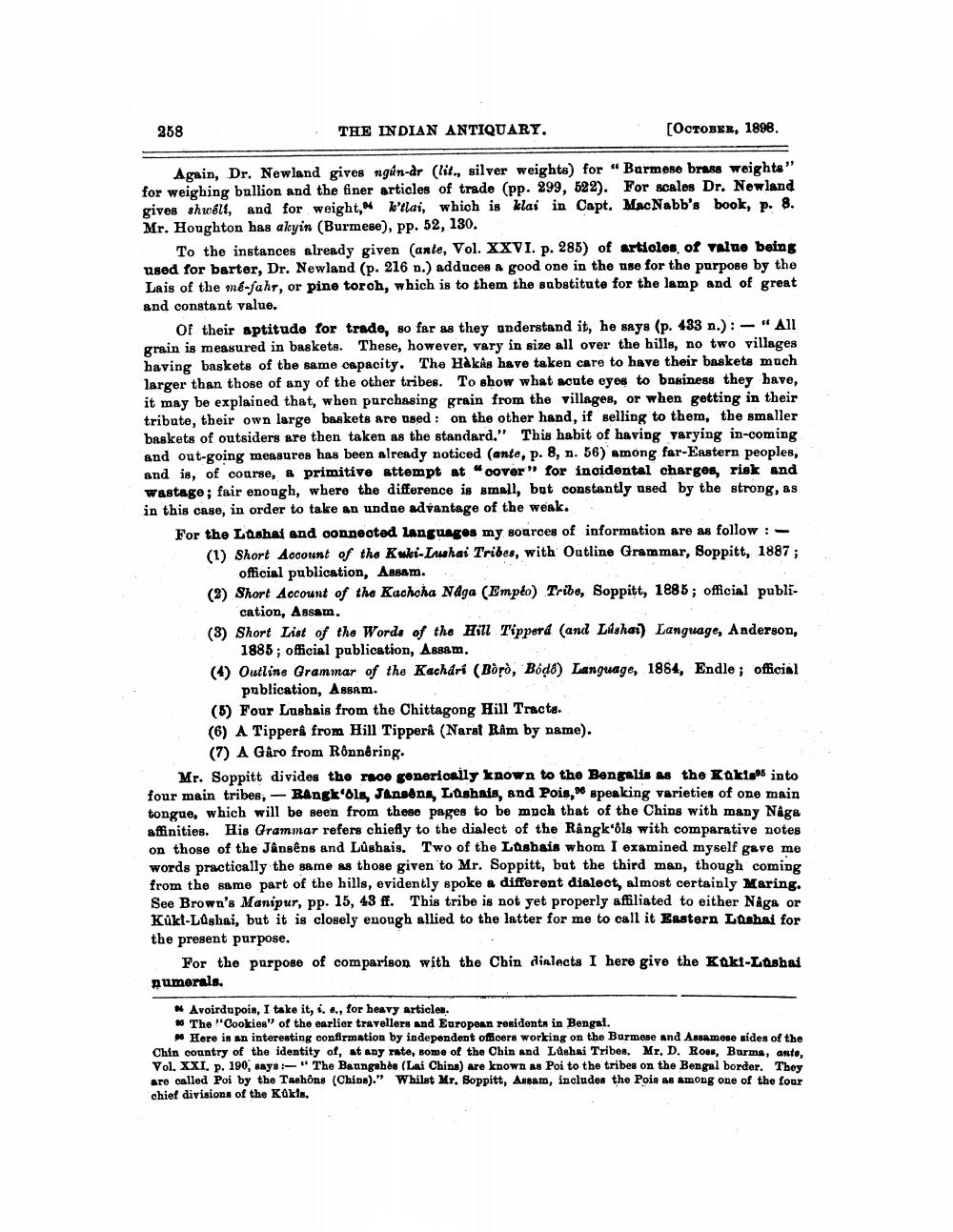________________
258
THE INDIAN ANTIQUARY.
(OCTOBER, 1898.
Again, Dr. Newland gives ngún-dr (lit., silver weights) for "Barmese brass weighte" for weighing bnllion and the finer articles of trade (pp. 299, 522). For scales Dr. Nowland gives shwell, and for weight, l'llai, which is klai in Capt. MacNabb's book, p. 8. Mr. Houghton has akyin (Burmese), pp. 52, 130.
To the instances already given (ante, Vol. XXVI. p. 285) of artioles, of value being used for barter, Dr. Newland (p. 216 n.) adduces a good one in the use for the purpose by the Lais of the mé-fahr, or pine torch, which is to them the substitute for the lamp and of great and constant value.
Of their aptitude for trade, so far as they onderstand it, he says (p. 433 n.): - "All grain is measured in baskets. These, however, vary in size all over the hills, no two villages having baskets of the same capacity. The Hakâs have taken care to have their baskets much larger than those of any of the other tribes. To show what acute eyes to bnsiness they have, it may be explained that, when purchasing grain from the villages, or when getting in their tribute, their own large baskets are need : on the other hand, if selling to them, the smaller baskets of outsiders are then taken as the standard." This habit of having varying in-coming and out-going measures has been already noticed (ante, p. 8, n. 56) among far-Eastern peoples, and is, of course, a primitive attempt at "cover" for incidental charges, risk and wastage; fair enough, where the difference is small, but constantly used by the strong, as in this case, in order to take an undue advantage of the weak. For the Loshai and connected languages my sources of information are as follow:(1) Short Account of the Kulci-Luhai Tribes, with Oatline Grammar, Soppitt, 1887;
official publication, Assam. (2) Short Account of the Kachoha Ndga (Empćo) Tribe, Soppitt, 1885; Official publi
cation, Assam. (3) Short List of the Words of the Hill Tipperd (and Lishai) Language, Anderson,
1885; official publication, Assam. (4) Outline Grammar of the Kachári (Bòrò, Bodd) Language, 1884, Endle ; official
publication, Assam. (6) Four Lushais from the Chittagong Hill Tracts. (6) A Tippers from Hill Tippera (Narsl Ram by name).
(7) A Garo from Rônnêring. Mr. Soppitt divides the moe gonerioally known to the Bengalis as the Kakion into four main tribes, - Bangk'Ols, Janadny, Loshais, and Pois," speaking varieties of one main tongue, which will be seen from these pages to be mpch that of the Chins with many Naga affinities. His Grammar refers chiefly to the dialect of the Rangk'8ls with comparative notes on those of the Jânsens and Lushais. Two of the Lasbain whom I examined myself gave me words practically the same as those given to Mr. Soppitt, but the third man, though coming from the same part of the hills, evidently spoke a different dialect, almost certainly Maring. See Brown's Manipur, pp. 15, 43 ff. This tribe is not yet properly affiliated to either Naga or Kúkt-Laghai, but it is closely enough allied to the latter for me to call it Eastern Loshal for the present purpose.
For the purpose of comparison with the Chin dialects I here give the Kaki-Lashai numerals.
Avoirdupois, I take it, i, .., for heavy articles. * The "Cookies" of the earlier travellers and European residents in Bengal.
Here is an interesting confirmation by independent officers working on the Burmese and Assamese sides of the Chin country of the identity of, at any rate, some of the Chin and Lushai Tribes, Mr. D. Ross, Burma, ante, Vol. XXI. P. 190, says:-"The Baungahda (Lai China) are known as Poi to the tribes on the Bengal border. They are called Poi by the Tachons (China)." Whilst Mr. Soppitt, Assam, includes the Pois as among one of the four chief divisions of the Kukis.




